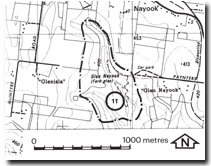11. Glen Nayook Granite Caves
|
This information has been developed from one or more of these publications:
|
| Location: | Neerim – 067015. Tarago River East Branch two kilometres west of Neerim Junction. | |
Access: | Paynters Road. | |
Ownership: | Crown Land. | |
Geology/Geomorphology: | Two stream passage caves occur in the Tarago River East Branch channel. The bedrock in the channel is Tynong Granite. The stream passages may be developed around corestones of granite boulders and extend for approximately 100 metres. There are several vertical entrances and stream sinks but the caves are largely impassable and their length, dimensions, and mode of origin has not been investigated in detail. | |
Significance: | State. The extent of cave development in granitic rocks has only recently been recognised. There has been little scientific investigation of the mode of origin and rate of cave development in these rocks and all recorded sites must be regarded as being high significance. | |
Management: | Class 1. Cave sites are extremely sensitive to disturbance, both from activities above ground and from changes in the streamflow or groundwater regime. No dumping of rubbish, quarrying, earthworks, construction or stream diversion works should be permitted in the area of the site. | |



